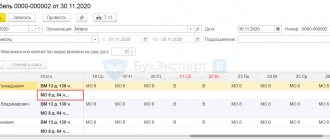Why is it necessary to keep track of working hours?
Timing of working time is understood as a process during which an employee, independently or with the assistance of colleagues who have the necessary competencies, monitors his own actions while at work for their content and duration.
Timing thus records what exactly an employee does during working hours, as well as how long each of his activities lasts. Why is this necessary?
First of all, the employer is interested in keeping track of employees' working hours - in order to evaluate and improve the efficiency of staff work. In addition, timing can also be used to:
- equipment load assessments;
- assessing the effectiveness of the implementation of management decisions in terms of individual business processes (and subsequent determination of the mechanisms for their necessary adjustment).
Through this procedure, the employer can identify:
- the percentage of employees performing useful actions during working hours;
- duration of downtime or actions not related to the work function;
- how the first 2 indicators change over time - when comparing several timings carried out in a row.
Timing is, in essence, an inventory of working time: identifying its quantitative indicators in relation to local business processes (production, management).
The employee himself may also be interested in keeping track of his working time - in order to increase work productivity, which will result in more intensive implementation of plans, if any, and ultimately - receiving a higher salary.
The initiators of the timing of working hours at an enterprise can be different subjects: business owners who are interested in increasing labor productivity; top managers of the company, also interested in achieving high production indicators; heads of departments; ordinary employees.
There are 3 main operations within the timing of working hours:
- preparation of timekeeping forms - for a specific position or job function;
- collecting data (filling out appropriate forms) in relation to the employee’s time at work;
- analysis and interpretation of timing data.
Let us consider the features of each of these operations in more detail.
Accountant work rationing
admin 04/05/2021 Articles Contents
- Data collection and interpretation
- On accounting for actual labor costs of specialists
- 1. General part
- 2. Labor organization
- 3.
Regulatory part - An example of calculating the number of employees in the financial service
- 1. General part
- 2.7. Rationing of labor costs
- 2. Labor organization
- Main stages
- New entries:
- Example
- What is working time tracking?
- “Standard time standards for work on accounting and financial activities in state (municipal) institutions.
CODE 14.08.01" (approved by the Federal State Budgetary Institution "Research Institute TSS" of the Ministry of Labor of Russia 07.03.2014 N 003) - An example of calculating the number of employees in the financial service
- 3. Regulatory part
- Rules and requirements
What is working time tracking?
Such a method is necessary in order to carefully study how exactly an employee spends his time at the enterprise.
Using timekeeping, you can determine in percentage terms how many hours or minutes are spent on rest, how many are spent on productive work, and how many are required to prepare the work process. But in order to conduct a correct assessment, it is necessary to track all the employee’s actions during a certain period.
Most often this is one working day, but it is not always possible to see an accurate picture of what is happening in such a short time. Therefore, certification can continue for several days.
Next, average indicators are given, on the basis of which conclusions are drawn.
With the help of timekeeping, you can not only identify labor efficiency, but also create more favorable conditions for a certain position. If it turns out that the employee’s workload is too heavy, he may be given assistants.
How to prepare forms for timekeeping?
When preparing timekeeping forms, it is important to first determine:
- what actions or activities of the employee while at work will be recorded;
- in what units of measurement the duration of the corresponding actions or activities will be reflected.
So, timing objects can be:
- actions in the main computer program through which the employee performs his job function, for example, “1C” if he is an accountant, or Photoshop if he is a designer;
- making telephone calls by an employee;
- employee writing emails;
- employee participation in meetings and planning sessions;
- breaks from work - for tea, lunch;
- other actions within the office that have no connection with the work function, but are an integral part of the work process, such as changing clothes, loading a PC, waiting for updates to its databases and software components.
Timing can be carried out in connection with a specific technological process - for example, to the stages of production of goods produced on the factory line of an enterprise. In this case, timing objects can be:
- loading materials onto the conveyor;
- assembly of the product on a conveyor;
- checking the quality of the assembled product;
- descent of the finished and tested product from the assembly line.
Or the same processes, but performed by specific workers (responsible for loading, assembly, etc.).
Regarding the units of measurement of the duration of an employee’s actions or activities, these can be expressed in seconds, minutes, hours, and sometimes days. Their choice depends, first of all, on the goals set by the company or its division responsible for timekeeping - to improve the employee’s productivity during the work shift (or part of it - for example, before lunch), week or month.
50. Timing and “photography” of the working dayIn the process of observation, the psychologist receives all the necessary information about the manifestations of labor behavior in various situations, about communication processes, about working conditions, etc. For a more clear, objective and clear picture, such methods of labor psychology as “photography” of the working day and timing.
Timing, as a rule, serves to determine and analyze labor standards and determine their duration. It is advisable to time auxiliary technical and logical operations - both manual and machine-manual, related to the operational or preparatory-final period.
Timing is used to:
1) to determine and sometimes establish time standards that are necessary to perform labor operations. Basically, the time standards established for performing a certain type of operation depend on the degree of complexity of the individual elements;
2) to check the already existing documented standards of time and the degree of their implementation in work activity;
3) to identify the reason for non-compliance with established standards;
4) to determine labor costs when operations are too short-term and cannot be recorded by other methods.
To carry out timing, use the usual or graphic form of a chronocard. Before conducting timekeeping, the psychologist needs to inform the employee and talk about the tasks and goals of the upcoming timekeeping, and try to relieve stress from the employee.
A “photography” of a working day is a temporary registration of all labor actions performed by an employee during one working day: work schedule, rest time, forced stoppage of work, etc. For more complete and most accurate observation, it should be carried out in stages:
1) preparation for observation;
2) conducting observation;
3) processing of observation data;
4) analysis of the results and preparation of measures to improve the organization of work or establish norms and standards.
In preparation for observation, the following parameters are studied:
1) the technological process that is performed by the administrator when performing his labor functions;
2) organization of work in the workplace;
3) service procedure;
4) technical characteristics, operating modes. All received data is recorded in a special form, according to which a schedule is subsequently constructed, reflecting the alternation of work and rest during the working day, the ratio of functions and the time required to perform these functions.
Table of contents
How is timing data collected?
This problem can be solved by:
- manually entering data into timekeeping forms;
- automated data entry into appropriate forms.
In the first case, the main actions may be assigned to the employee himself or to a responsible person who will supervise the employee’s work. The second option for collecting timing data involves the use of various computer algorithms.
The choice of the first or second option for data collection depends on the specifics of the employee’s specific job function, as well as on the technical ability and efficiency of recording this or that type of data for timing in the first or second way.
For example, if we are talking about recording data on the use of programs specialized for a person’s work function, then the optimal way to solve this problem is automation, which involves the use of other programs that can track the intensity with which the employee accesses his software.
When it comes to timing the stages of a product assembly line, it may be preferable (due to less complex technical feasibility) to use a method of manually entering data into the timing form.
Once the timing data is collected, the employee or his colleague who has the necessary competencies has another task - to correctly interpret the statistics obtained.
How is timing interpreted?
Timing data can be interpreted through:
- visualization of employee action statistics;
- factorial, comparative analysis of relevant statistics;
- identifying dependencies between indicators reflecting the dynamics of actions performed by an employee and indicators of economic importance (for example, the number of goods produced over a specified period of time).
Often all of these methods of interpreting timing data are performed simultaneously by the employee or a competent colleague.
Based on the data obtained during timekeeping, as well as their analysis, the enterprise can make certain personnel decisions, issue methodological recommendations on improving the quality of employees’ performance of work functions, generate analytical reports for investors - the options for possible application of the results of timekeeping can be very different.
Labor rationing in the accounting service. Features of calculations
Department heads and company directors are regularly forced to evaluate how busy their subordinates are.
Firstly, this is necessary in order to understand whether employees are coping with their work. If they fail, is it because they are not working at full capacity or, conversely, are they not able to complete all the tasks because the company does not have enough people? To answer this question, a workload assessment is needed. And secondly, in order to justify to senior management the need to hire new employees or reduce existing ones.
The workload of different specialists is assessed differently. The work of a journalist is measured by the volume and number of texts, the amount of work of a teacher is measured by hours and the number of students. To assess the efficiency of these specialists, the deadlines and the number of proofreading and editorial changes are used - in the case of a journalist, the results of tests and tests - in the case of a teacher. But measuring the volume of work and its quality in other specialties can be much more difficult. For example, how to determine the amount of work and efficiency of an accountant?
The method of factor rationing is actively used abroad, but it has not yet become widespread in Russia. But first, it’s worth understanding the very concept of rationing and its types.
Rationing is the determination of labor cost standards for specific processes or operations (that is, the required amount of time for one employee to obtain a unit of result). Labor cost standards are the required number of man-hours (or other units of measurement) to obtain a unit of work result. First you need to calculate the current labor costs at the enterprise or in the department, then compare them with pre-calculated standards. The type of standardization used for different companies depends on the method of calculating these standards.
Obviously, any production process can be the subject of regulation. But is it possible to make accounting such an object? To do this, you need to make sure that the accounting process is not unique. It implies the presence of such components as performers, incoming information, rules and regulations (legislative and local), established practice and the output result (accounting statements).
Previously, microelement rationing and timing in production were popular in our country. There were entire volumes of standards for various specialties. But with the development of automation and changes in technology, this method has ceased to be profitable and convenient: the standards would have to be changed too often, and a huge staff of raters with a stopwatch who will measure the time of each worker’s action is not what modern production strives for. In addition, timing and microelement rationing methods are only suitable for industrial operations. And today, companies also need to standardize business processes.
The workday photography method, similar to timekeeping, involves recording all the employee’s actions during the day, including rest time. This method is also more relevant in production, and in the case of intellectual work it will help a specialist manage his working time more effectively.
A more applicable method to business processes is benchmarking. This is a comparison of labor costs for specific processes in different industries. At the same time, the most successful companies in each industry are selected and their standards are accepted as the ideal to which one should strive. This method is quite simple and does not require processing a large amount of information. But it does not take into account the specifics of each company in the industry: business volume, enterprise structure, organization of processes, etc.
The most optimal method for calculating standards for business processes is factor standardization. This is a method in which the required number of employees is calculated taking into account factors affecting the result of work. Let's look at it in more detail.
For factor standardization, it is necessary to divide the activities of the department into processes, for each of which it is necessary to estimate labor costs. Then, for each process, it is necessary to identify the factors that most strongly influence labor costs, and, taking them into account, calculate standards.
The activities of the accounting department can be divided into the following processes:
- accounting of cash transactions; accounting of settlements for banking transactions; accounting of settlements with accountable persons; accounting of settlements with suppliers and contractors; sales accounting;
- management and corporate reporting; accounting for long-term investments, fixed assets and intangible assets; inventory accounting; accounting of financial investments; accounting for financing and loans; tax reporting preparation; payroll preparation.
It is necessary to determine which of these areas are affected by accounting. Next, you need to calculate the labor costs for each process, taking into account the skill levels of the accountants involved. The next step is to identify the factors that most influence labor costs. For example, in the case of a process such as payroll, these factors are: the number of accruals and deductions; number of intersettlements; number of payslips.
In accounting for payments to suppliers:
- number of invoices;
- the average number of item items in the invoice.
After identifying the processes and determining the factors for each process, it is necessary to calculate the standard labor costs. For example, the standard for payroll calculation will be the number of employees (payslips) per month per accountant. And the standard for accounting for settlements with suppliers and contractors can be the number of invoices per hour per accountant.
Example of standard calculations
The company has 200 employees and 3 warehouses.
It is engaged in wholesale trade and works with 62 suppliers.
Each supplier receives 10 deliveries per month to each warehouse.
Each supplier is invoiced twice a month.
Photo of a social work specialist's working day
Contents Many managers notice that over time the productivity of their staff decreases. If employees or individual departments do not have time to cope with the tasks assigned to them, this cannot but affect the final result of the company's activities.
The reason may be either a high workload of workers or insufficient qualifications of the employee. In order to find an objective reason, an analytical method is used: a photograph of the working day. A working day photograph is a type of observation of the activities of an individual employee: an accountant, a cook, a manager, a secretary, a storekeeper, or a group of workers: engineers, economists, electric welders, in order to determine how much time they spend working.
Such an observation is intended to be transferred to paper and to see with your own eyes the real time spent on the work process.
When compiling a map, even telephone conversations that took several minutes are included in it.
As a result, the manager sees what his staff is actually doing throughout the working day and week. Important! Observation periods may vary. They are determined based on the complexity of the situation and the tasks assigned to the observer. The main goals of compiling a report based on the results of a photograph of a working day: to determine the structure of working time. It helps to identify the most time-consuming operation, type of work and determine the employee’s priorities, that is, if he spends more time on one task, then it is more important to him; study the experience of specialists who produce the best results.










